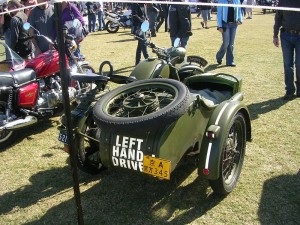In November, I fitted a new electronic ignition system to my motorbike.
A side effect of the conversion means that the bike has a lot more power, more acceleration, and can go faster than it ever went during the previous ten years.
Going faster means higher revs. … On 14th December I went tearing up Campbell’s Pocket Road from Wamuran to the Mount Mee Road flat out in third and occasionally second gears, never having to drop back to first as I did for much of that climb on the same Rally the previous year. I even overtook two other sidecars and some solo bikes on the way up the hill! Turned left onto Mount Mee Road and was easily hitting 85 to 90 km/h on the straight sections between corners. Suddenly the motor just died and I coasted to a standstill.
“Bugger!” (I said to myself) “That bloody rotor has come loose on the front of the crankshaft and I have lost my timing!”
I was wrong.
Several other rally riders stopped and the back-up trailer arrived. We all tried to start it: we proved the spark was strong and bright on both plugs; it obviously had plenty of compression, therefore no valve or piston problems; I filled the tank with petrol from the drum in the sidecar, so we all knew she wasn’t out of juice. The consensus of all was that she was getting a great spark, but at the wrong time, so the ignition timing must be out. And as we couldn’t hold everyone up by continuing to try starting it, for the first time in ten years of regular riding, my bike came home on a trailer! How ignominious!
At home I whipped off the front crankcase cover and the timing peephole at the flywheel, and amazingly, the timing was perfect, the rotor was as tight as a fish’s anus (that’s watertight) on the crankshaft, and there appeared to be nothing wrong! I put the front cover back on.
I turned on the fuel, pressed each tickler three times, kicked it slowly over both cylinders (exactly as I would any day for a cold start), turned on the ignition, set the throttle at 3 mm past the little scratch mark, and gave it a gentle kick. It fired up first kick as it always does! I went for a test ride of about 5 km around our suburb and it never missed a beat!
So what was wrong with it on the side of Mount Mee Road?
On analysing what we had done at the roadside, I remembered two things that were different: when I had first pulled up, the fuel tap was about half-way around from fully open to fully closed in a position where it should have had enough juice but would have been running a little lean; when we tickled the carbies, the fuel was “hissing” as it entered the float bowls.
On looking back, and thinking logically about it, the higher than usual revs going up Campbell’s Pocket Road had caused excessive vibration which, in turn, had caused the fuel tap to begin closing, so that the mixture had become lean. Lean mixture means hotter running, so the motor had become very hot. Heat from the motor had overheated the carbies. The petrol in the carbies had boiled dry, so the motor had just given up the ghost. It was all so simple when I stopped to think rationally about it.
If I had just told all the other riders to head off to the lunch stop and I would get there in half an hour anyway, I could have avoided the ignominy of having my bike trailered home for the first time ever!
Unfortunately, although I had my iPad in the sidecar, I took no photos that day.
My bike is a 1962 Chang Jiang M1M 750cc side-valve boxer twin with a heavyweight military sidecar.
